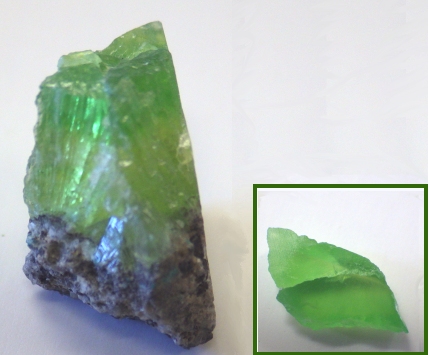Smithsonite Visible to Near-infrared Spectra (350 - 2800 nm)
Smithsonite, ZnCO3, a zinc carbonate, occurs in a variety of colors. An
absorption band centered at 937 nm that is responsible for the
bluish-green color arises from Cu2+,
a commonly associated minor component of the smithsonite. Cadmium (as
inclusions of the sulfide) is the cause of yellow color.
Images of representative smithsonite spectra
-
GRR164 spectrum; Kelly Mine,
New Mexico. Transluscent, light green, polycrystalline mass, 1.22 mm thick. The color comes from the absorption by Cu2+. Data File: unpolarized;
- GRR 3339 spectrum: Arizona; Transluscent green, polycrystalline mass
 , 1.299 mm thick, contains copper as the minor component and a trace of manganese. The color comes from the absorption by Cu2+ . Data File: polarized.
, 1.299 mm thick, contains copper as the minor component and a trace of manganese. The color comes from the absorption by Cu2+ . Data File: polarized.
Data Files
-
no other data files
Notes on the color of smithsonite
Blue-Green; From the Graphic Mine, Kelly, Socorro County, New Mexico.
Bershov et al (1968) examined blue smithsonite and concluded that Cu2+ isomorphously replaces Zn2+ in smithsonite.
Yellow; From Marion County, Arkansas
In 1938, Schaller and Fairchild attributed the color of yellow
smithsonite to the presence of greenockite (CdS) at the level of a few tenths of a
percent. Hurlbut (1954) analyzed smithsonite from the Broken Hill Mine,
Rhodesia and found 0.4 wt% FeO and 0.05 wt% CdO.
Light brownish to yellowish smithsonite from Katy, Poland, was
described by Zabinski (1958). He found iron contents ranging up to 15.8
wt% FeO. His X-ray data indicated that iron and zinc isomorphously
substitute for each other in smithsonite.
Pink; From Chihuahua, Mexico
Mincheva-Stepanova (1955) and Mincheva-Stefonova and Neikov (1991)
described raspberry-red to peach-colored smithsonite from Bulgaria that
contained up to 5.30 wt% CoO.
Others:
Light brownish to yellowish smithsonite from Katy, Poland, was
described by Zabinski (1958). He found iron contents ranging up to 15.8
wt% FeO. His X-ray data indicated that iron and zinc isomorphously
substitute for each other in smithsonite.
Bershov, L. V.; Mineeva, R. M.; Nyussik, Ya. M (1968) Forms of copper
entrance into some minerals. Geokhimiya 11, 1398-400. In
Russian.
Schaller WT, Fairchild JG (1938) Cadmium in smithsonite from New Mexico. American Mineralogist 23, 894-897.
Hurlbut CS (1954) Smithsonite from Broken Hill Mine, Rhodesia. American Mineralogist 39, 47-50.
Mincheva-Stepanova J (1955) A hydrothermal cobaltoan smithsonite.
Izvestiya na Geologicheskiya Institut, Bulgarska Akademiya na Naukite
3, 3-24. In German.
Mincheva-Stefanova, I, Neikov K (1991) Varieties of the hydrothermal
smithsonite from the Sedmochislenici deposit, western Stara Planina.
Geokhimiya, Mineralogiya i Petrologiya 27, 63-95. In Bulgarian.
Zabinski W (1958) Ferrosmithsonite (monheimite) from Katy near Chorzow.
Bulletin de l'Academie Polonaise de Sciences, Serie des Sciences,
Chimiques, Geologiques et Geographiques 6, 389-93.
Reference to smithsonite spectroscopy
 Back
to the list of minerals
Back
to the list of minerals
 Back
to the Index of Data Files
Back
to the Index of Data Files
 Back
to the
Mineral Spectroscopy home page
Back
to the
Mineral Spectroscopy home page
last
upgraded 9-July-2022 , 1.299 mm thick, contains copper as the minor component and a trace of manganese. The color comes from the absorption by Cu2+ . Data File: polarized.
, 1.299 mm thick, contains copper as the minor component and a trace of manganese. The color comes from the absorption by Cu2+ . Data File: polarized.
 , 1.299 mm thick, contains copper as the minor component and a trace of manganese. The color comes from the absorption by Cu2+ . Data File: polarized.
, 1.299 mm thick, contains copper as the minor component and a trace of manganese. The color comes from the absorption by Cu2+ . Data File: polarized.
 Back
to the Index of Data Files
Back
to the Index of Data Files